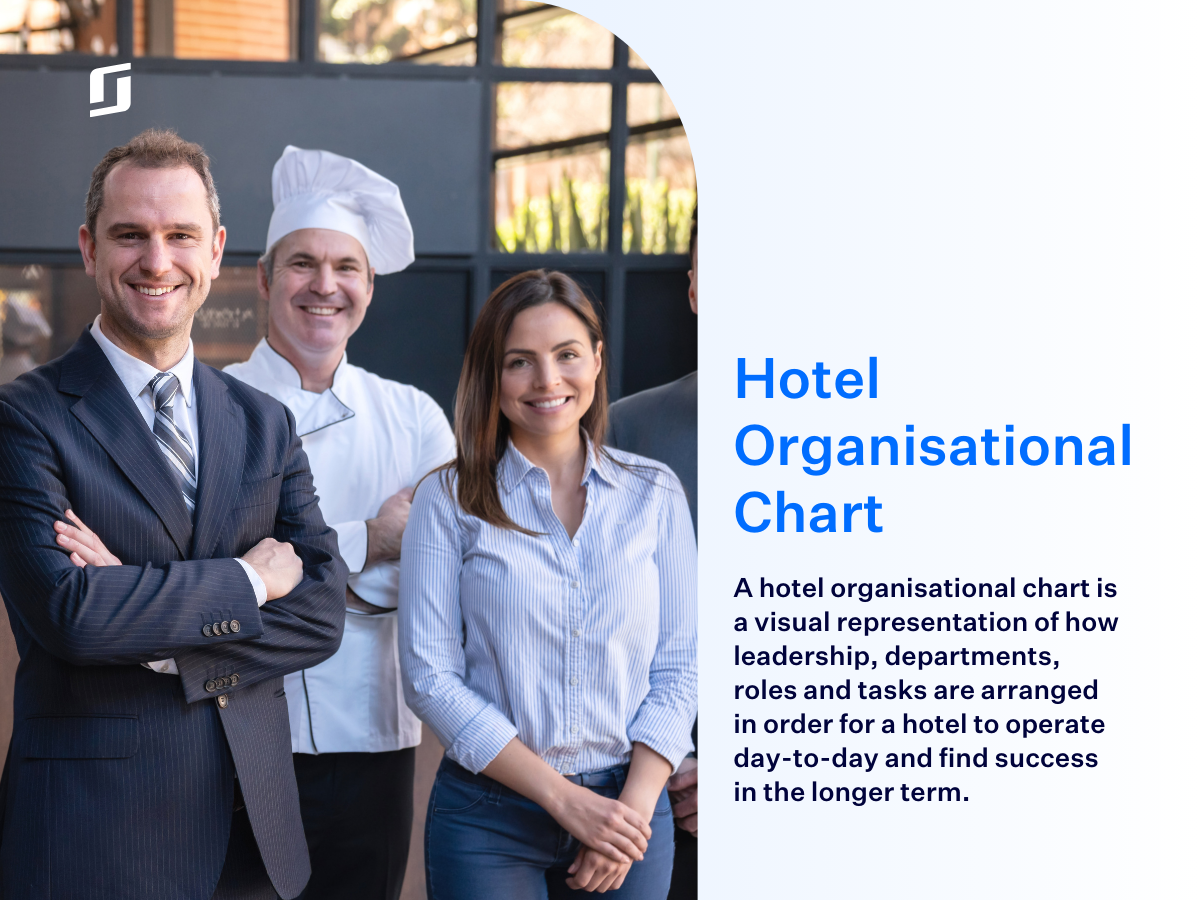What is a hotel organisational chart?
A hotel organisational chart is a visual representation of how leadership, departments, roles and tasks are arranged in order for a hotel to operate day-to-day and find success in the longer term.
Who reports to who? Which department is responsible for a certain project? Which role carries out a specific task? All of these questions and more can be answered by a hotel organisational chart, or sometimes referred to as a hotel hierarchy chart.
Hotel organisation charts can be powerful tools for hoteliers at any stage of business, providing the clarity and structure for better decision-making and empowering people across the organisation to do their best work.
Here, we cover everything you need to know about creating and using a hotel organisation chart – with examples provided.
Table of contents
What are the benefits of a hotel organisational chart?
A hotel organisational chart provides a way for staff and stakeholders to navigate the business internally. It provides a foundation on which processes are built and gives clarity around business structures, hierarchies, lines of authority, business reporting relationships, roles and responsibilities.
This clarity can:
- Boost efficiency and communication
- Improve collaboration and communication
- Empower employees and managers
- Help onboard new employees
- Assist with resource planning and decision making
Make your organisation more efficient with smart software SiteMinder's platform gives your staff more control and allows them to do more, ultimately increasing performance.
How important is a hotel hierarchy chart?
For medium to large-sized hotels, the creation of a well-defined hotel hierarchy chart is a critical step towards operational excellence. This tool is essential not just for organisation, but for fostering a clear understanding of roles, responsibilities, and the flow of communication within the hotel.
How important is it to have a well defined and organised hotel organisational structure?
An effective and well-crafted hotel hierarchy chart is the backbone of a hotel’s framework, paving the way for streamlined operations and exceptional guest services. Here are just a few of the reasons why they’re considering so fundamental:
- Streamlining operations: Clear roles and responsibilities outlined in the hierarchy ensure operational efficiency, preventing overlap and confusion.
- Enhancing communication: The hierarchy establishes direct communication channels, crucial for swift issue resolution and effective team collaboration.
- Facilitating training and development: It offers a clear path for employee onboarding, training, and career progression, enhancing staff engagement and retention.
- Aiding in conflict resolution: A structured hierarchy helps quickly identify and address disputes, maintaining harmony and productivity.
- Improving customer service: A well-organised back-end structure directly translates to superior front-end guest experiences, with rapid response to guest needs.
- Assisting in decision making: Strategic planning and decision-making are more cohesive and aligned when the organisational structure is clear.
Sample of organisational chart of hotels
A close examination of your hotel organisational structure will inform the format and inclusions for your hotel organisational chart. Factors you need to consider include:
- The size of your hotel
- The number of departments and employees
- The role, responsibilities and functions of each department
- The relationship between departments
- Hotel business staff structure
If you’re creating a hotel organisational chart with duties and responsibilities, you’ll also need to cover the role, responsibilities and functions of each employee and who each employee needs to communicate with to get the job done.
Typically, for hotel and resort organisational charts, there are four types of charts that you might follow:
Hierarchical Hotel Organisational Chart
As the name suggests, this chart reflects a traditional business structure with senior leaders at the top and the structure divided into traditional hotel departments such as finance, front office, human resources, food and beverage, sales and logistics. It can be used in both large and small hotels.
Functional Hotel Organisational Chart
A functional hotel organisational chart includes the hierarchical organisational structure along with positions listed according to their function in the hotel and the skills the position requires. This is a popular type of chart, though is sometimes criticised for contributing to silos within an organisation and hampering communication between departments.
Matrix Hotel Organisational Chart
The matrix chart accommodates organisational structures where multiple departments work cross-functionally. This style avoids the complexity that would otherwise occur with the hierarchy chart in this situation.
Flat Hotel Organisational Chart
Often used by start-ups, this type of chart is also preferred by companies wanting to empower all employees by encouraging self-management and greater decision making ability. It’s a horizontal chart showing few or no levels of management between executives and all other employees.

How to use organisational chart for hotels
Organisational charts in hotels are practical tools, crucial for both new and existing staff. They provide a clear picture of everyone’s role and where they fit in the hotel’s structure. These charts are not just for show; they’re working documents that guide staff on who to contact for different issues, making daily operations smoother.
Their primary use case is fairly simple: ensuring that everyone knows who reports to who, who is responsible for what team, and ultimately, where the “buck stops”. Organisational charts make it far easier for the hotel team to keep track of everyone and what their roles are.
These charts also inspire staff by showing all the career opportunities available within the hotel. They’re a visual representation of where you could go in your career, boosting morale and motivation.
For management, organisational charts are essential for strategic planning. They help in resource allocation, financial planning, and identifying staffing needs. These charts make it easier to see where to add new roles or make changes for better efficiency.
In recruitment and business planning, an organisational chart highlights possible gaps in the team and helps align staffing with the hotel’s long-term goals. This ensures the hotel isn’t just running well now, but is also set for future growth.
What are the roles of the organisational chart for hoteliers?
While an organisational chart is useful for hotel staff as a whole, every department can benefit from the use of an organisational chart in unique and powerful ways.
Financial
For the financial team, an organisational chart is a roadmap to understand the interdepartmental flow of financial information and transactions. It helps in identifying the key personnel in each department who are responsible for budgeting, reporting expenses, and revenue management. This clarity ensures efficient communication and accurate financial reporting, essential for maintaining the hotel’s financial health.
Front office
The front office staff use the organisational chart to understand the hierarchy within their department and the hotel at large. It helps them identify who to report to for daily operational issues and who handles specific guest concerns or special requests. This clarity is crucial in providing swift and effective guest services, a core function of the front office.
Human resources
In human resources, the chart is used to manage staffing efficiently. It aids in identifying staffing needs across the hotel, ensuring each department is adequately staffed. The chart also helps in tracking employee career progression, supporting recruitment, and managing staff rotation or internal promotions, thus playing a crucial role in employee development and satisfaction.
Food & beverage
For the food & beverage department, the chart is essential for understanding the complex structure within the department, including kitchen staff, servers, and managerial roles. It helps in managing the workflow and coordination between different sections, such as the kitchen, bar, and dining areas, ensuring seamless service delivery and high-quality guest experience in dining. This is particularly important for hotels who may have multiple different forms of food & beverage service, such as a restaurant, a bar, and room service, all which may have different staff involved in different ways.
Sales
The sales team uses the organisational chart to identify key decision-makers both within and outside the hotel structure. This knowledge is crucial for developing targeted sales strategies and creating bespoke proposals for new guests. Understanding the hierarchy helps in effective communication and negotiation, ensuring that the most appropriate team leads are looped into major proposals, leading to successful sales and partnerships.
Logistics
In logistics, the chart is crucial for understanding how different departments interact and depend on each other for supplies and services. It helps in planning and coordinating deliveries, maintenance, and other logistical needs, ensuring that all departments receive timely support without disrupting the hotel’s operations.
Tips on hotel hierarchy and staff structure
To get the most from your hotel organisational structure, keep these things in mind when creating your chart:
- Make it easy-to-update and accessible – so you can quickly accommodate changing needs and business priorities and your people can use it day to day
- Get feedback from all departments and people – talk to your managers and people about whether it really reflects what is needed to keep operations running smoothly
- Make sure it ties in with and supports your business vision, aims and goals
- Check that it includes all the information necessary to help you and your people do your jobs and make decisions
- Eliminate any information which only serves to over-complicate the chart
Remember to update it and use it when hiring, training, managing, and motivating your whole team of staff.

